
If you were alive in the year 1970, more than one in four birds in the U.S. and Canada has disappeared within your lifetime.
FIND OUT MORE
We've Lost Nearly 3 BILLION Birds Since 1970
View From Sapsucker Woods
How to Fix the Bird Declines: A To-Do List For Government, Business And Individuals
Seven Simple Actions to Help Birds
According to research published online in September by the journal Science, wild bird populations in the continental U.S. and Canada have declined by almost 30% since 1970.
“We were astounded by this net loss across all birds on our continent, the loss of billions of birds,” said Cornell Lab of Ornithology conservation scientist Ken Rosenberg, who led an international team of scientists from seven institutions in the analysis of population trends for 529 bird species.
Our results signal an urgent need…to avert continued biodiversity loss and potential collapse of the continental avifauna.
~from the 2019 Science article
The study quantifies for the first time the total decline in bird populations in the continental U.S. and Canada, a loss of 2.9 billion breeding adult birds—with devastating losses among birds in every biome. Rosenberg, who leads joint research initiatives by the Cornell Lab and American Bird Conservancy, says these study results transcend the world of birds.
“These bird losses are a strong signal that our human-altered landscapes are losing their ability to support birdlife,” he said. “And that is an indicator of a coming collapse of the overall environment.”
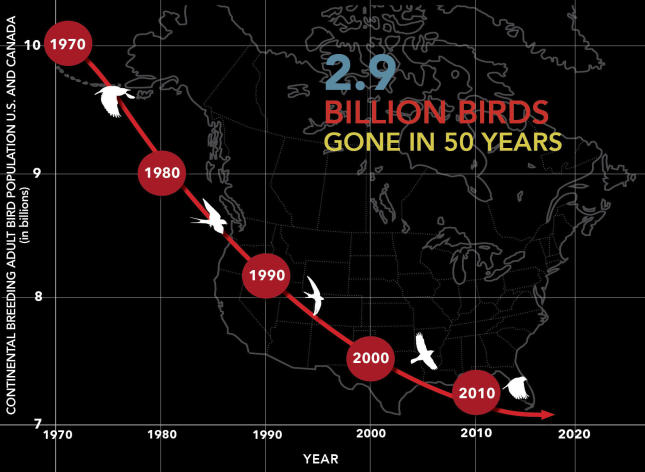
Graphic by Jillian Ditner.
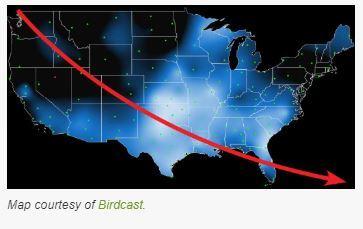
RADAR ALSO SHOWS A DECLINE
For this analysis, the research authors augmented their population models with another source and method of measuring bird abundance. They looked to the skies at what they can directly observe—via more than 140 NEXRAD weather radar stations across the United States.
Birds can be seen on radar, especially in spring when they migrate high in the air at night. Cornell Lab of Ornithology aeroecology specialist Adriaan Dokter conducted the analysis of birds visible on radar imagery during nighttime spring migration, and he also found a decline.
“The amount of ‘bird biomass’ flying over our heads has decreased by about 14% since 2007,“ Dokter said. According to the analysis, the declines were steepest among radar stations in the eastern half of the country.
2.9 Billion Birds Gone
The scale of loss portrayed in the Science study is unlike anything recorded in modern natural history. While the Passenger Pigeon likewise suffered cascading losses more than a century ago, that was a population loss among one species, mostly in eastern North America. This research portrays massive losses among hundreds of species of birds from coast to coast.
The population models in this study are based on several decades of standardized bird-survey datasets. This research represents the most robust synthesis of long-term population monitoring data ever assembled for animals, says Adam Smith, a study coauthor and biostatistician for Environment and Climate Change Canada.
“It’s safe to say that in the natural world, birds are the best studied group of wildlife species,” Smith said. “The data that exist for birds are just so incredible, from 50 years of the North American Breeding Bird Survey and the Christmas Bird Counters from 100 years ago, on to the eBirders of today.
“With this study, we have finally managed to come up with a way to estimate the number of birds in North America, to get to a point where we trust the math. And it turns out, over less than a single human lifetime, we’ve lost almost a third of our birds.”
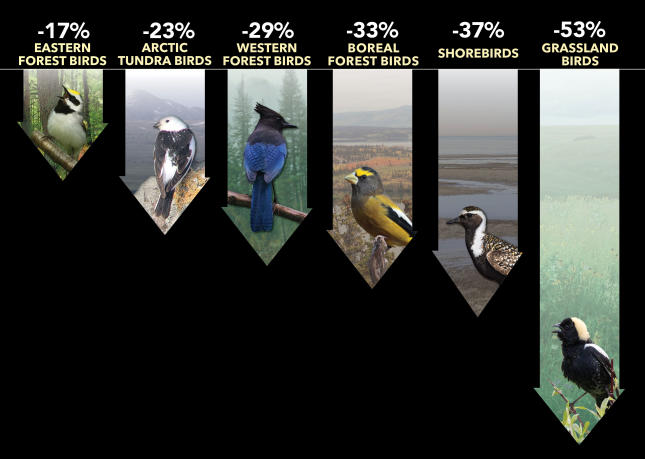
Graphic by Jillian Ditner. Photo credits appear at the end of this article.
Declines In Every Biome
The study authors say their work doesn’t just show a massive loss of birdlife, but a pervasive loss that reaches into every biome in the U.S. and Canada.
These bird losses are a strong signal that our human-altered landscapes are losing their ability to support birdlife.
~Ken Rosenberg, Cornell Lab of Ornithology
Forests alone have lost 1 billion birds. Grassland bird populations collectively have declined by more than 50%, or another 700 million birds. Habitat loss is likely to be a driving factor in these declines, say the authors, particularly agricultural intensification and development.
“I think this analysis shows that we’re eating away at the foundations of all of our major ecosystems on the continent,” said Arvind Panjabi, study coauthor and avian conservation scientist at the Colorado-based Bird Conservancy of the Rockies. “These numbers show that the world has changed a lot since 1970.”
For Adam Smith, the Environment and Climate Change Canada biostatistician, the numbers call out for a radical shift in conservation strategy.
“It’s really a wake-up call for the importance of moving beyond just a single species, endangered species conservation framework,” Smith said. “We rescued the Trumpeter Swan and the Peregrine Falcon, and we should be proud and happy about those successes. But we’re at a stage where, given these extreme declines in so many species, we need to move beyond that framework.
“These are systems and biomes in serious trouble. I think we need to approach conservation of these endangered systems at a much more holistic level.”
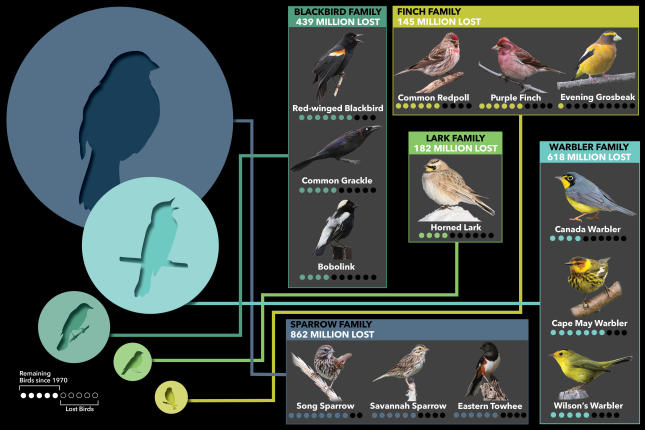
The circles show total losses within 5 common bird families. For representative species within each family, losses are shown using dots. Colored dots represent the proportion of population still living; black dots represent the proportion of lost birds since 1970. Graphic by Jillian Ditner. Photo credits appear at the end of this article.
Steep Losses Among Major Bird Families
More than 90% of the total loss of birdlife in the U.S. and Canada (more than 2.5 billion birds) comes from just 12 avian families, including sparrows, blackbirds, and finches.
These so-called common birds—the species that many people see every day—represent the greatest losses of birdlife. Take the Red-winged Blackbird, for instance. Certainly it’s still a common bird; the study estimates a population of more than 170 million red-wings today. But just 50 years ago there were more than 260 million, meaning a third of the entire population has eroded in half a century. Red-winged Blackbirds are a common bird species that is suffering severe, unsustainable losses.
Study coauthor Peter Marra, director of the Georgetown Environment Initiative, points out that the cascading losses among blackbirds have an echo in avian history: “That’s what happened with the Passenger Pigeon, a bird that was really common and nobody thought could ever go extinct.”
Rosenberg, the study’s lead author, says the findings about common birds are some of the most concerning: “We’re squeezing the planet so hard, in terms of using resources and space. And now we’re reaching this tipping point.
“We’re squeezing out that last bit of space, the last common birds on the landscape are declining, and we’re losing hundreds of millions of birds.”
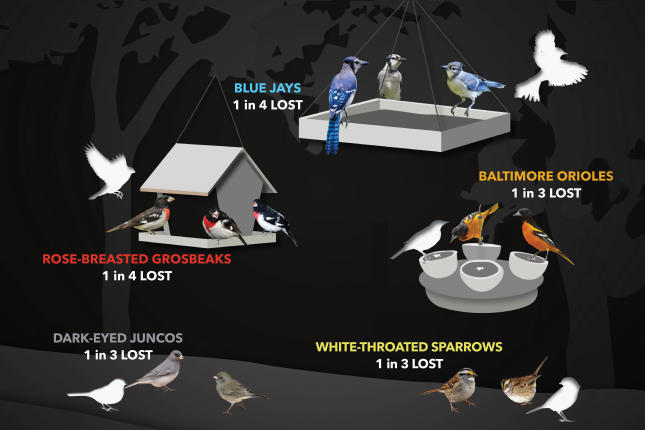
Some Of America’s Favorite Birds Are Disappearing
Steep declines among birds that people regularly see at bird feeders can be insidious. The flocks of birds are still there, so most people don’t detect a loss of abundance. “There’s a shifting baseline phenomenon,” said Adam Smith, the study coauthor and biostatistician.
“Because the declines are gradual, we lose track of just how abundant these birds used to be.” But the research findings in this analysis are clear: Some of America’s most familiar and beloved backyard birds are rapidly disappearing.

Wetlands conservation efforts and dedicated conservation funding like the Duck Stamp have paid off with healthy waterfowl populations for sport hunting. Hawks and falcons benefited greatly from focused conservation policy, such as Endangered Species legislation and the banning of harmful pesticides such as DDT. The impressive gains among some game birds such as Wild Turkey are due to the effectiveness of dedicated conservation funding and enterprising efforts of hunting groups.
The Good News: Some Birds Are Doing Well, And We Can Learn From Them
Not all the news out of this analysis is dire. Some groups of birds are doing well, and for good reason—governments and societies have invested in saving them. Raptors, waterfowl, and turkeys show what’s possible when commitments are made to bird conservation.
The successes of the past are the candles in the dark that will guide us towards solutions in the future.
~Adam Smith, Environment and Climate Change Canada
“When we’ve invested to combat declines for a particular group birds, we’ve succeeded,” said study coauthor Arvind Panjabi, alluding to the waterfowl population increases attributable in part to the billions of dollars in habitat conservation work made possible by the North American Wetlands Conservation Act. “Other birds could benefit from a similar approach,” Panjabi said.
As Rosenberg, the study’s lead author, points out, even if 30% of North America’s birds are lost, there are still 70% left to spur a recovery if conservation measures can be implemented. But action must come soon.
“I don’t think any of these really major declines are hopeless at this point,” Rosenberg said. “But that may not be true 10 years from now.”

